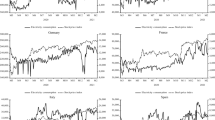Abstract
The decomposition-based vector autoregressive model (DVAR) provides a new framework for scrutinizing the efficiency of technical analysis in forecasting stock returns. However, its relationships with other technical indicators still remain unknown. This paper investigates the relationships of DVAR model with the Japanese Candlestick indicators using simulations, theoretical explanations and empirical studies. The main finding of this paper is that both lower and upper shadows in Japanese Candlestick Granger contribute to the DVAR model explanation power, and thus, providing useful information for improving the DVAR forecasts. This finding makes sense as it means that the information contained in the lower and upper shadows should be used when modeling the stock returns with DVAR. Empirical studies performed on China SSEC stock index demonstrate that DVAR model with upper and lower shadows as exogenous variables does have informative and valuable out-of-sample forecasts.
Similar content being viewed by others
References
Malkiel B G, The efficient market hypothesis and its critics, Journal of Economic Perspective, 2003, 17: 59–82.
Billingsley R S and Chance D M, The benefits and limits of diversification among commodity trading advisors, Journal of Portfolio Management, 1996, 23: 65–80.
Park C H and Irwin S H, What do we know about the profitability of technical analysis?, Journal of Economic Surveys, 2007, 21: 786–826.
Schwager J D, Market Wizards: Interviews with Top Traders, Harper-Collins New York, 1993.
Schwager J D, The New Market Wizards: Conversations with America’s Top Traders, JohnWiley & Sons Hoboken, N. J., 1995.
Covel M W, Trending Following: How Great Traders Make Millions in Up or Down Markets, Prentice-Hall New York, 2005.
Hasanhodzic J, The Evolution of Technical Analysis: Financial Prediction from Babylonian Tablets to Bloomberg Terminals, John Wiley & Sons Hoboken, N. J., 2010.
Cowles A, Can stock market forecasters forecast?, Econometrica, 1933, 1: 309–324.
Fama E F and Blume M E, Filter rules and stock market trading, Journal of Business, 1966, 39: 226–241.
Jesen M C and Benington G A, Random walks and technical theories: some additional evidence, Journal of Finance, 1970, 25: 469–482.
Brock W, Lakonishok J, and LeBaron B, Simple technical trading rules and the stochastic properties of stock returns, Journal of Finance, 1992, 47: 1731–1764.
Sweeney R J, Beating the foreign exchange market, Journal of Finance, 1986, 41: 163–182.
Levich R M and Thomas L R, The significance of technical trading rule profits in the foreign exchange market: A bootstrap approach, Journal of International Money and Finance, 1993, 12: 451–474.
Neely C, Weller P, and Dittmar R, Is technical analysis profitable in the foreign exchange market? A genetic programming approach, Journal of Financial and Quantitative Analysis, 1997, 32: 405–426.
Lo A W and MacKinlay A C, A Non-Random Walk Down Wall Street, Princeton University Press Princeton, 1999.
Lo A W, Mamaysky H, and Wang J, Foundations of technical analysis: Computational algorithms, statistical inference, and empirical implementation, Journal of Finance, 2000, 55: 1705–1765.
Neely C, Rapach D E, Tu J, and Zhou G F, Forecasting the equity risk premium: The role of technical indicators, 2011, available at “http://research.stlouisfed.org/wp/2010/2010-008.pdf”.
Malkiel B G, A Random Walk Down Wall Street (Revised edition), W.W. Norton New York, 2011.
Xie H B and Wang S Y, A new approach to model financial market, Journal of Systems Science and Complexity, 2013, 26(3): 432–440.
Parkinson M, The extreme value method for estimating the variance of the rate of return, Journal of Business, 1980, 53: 61–65.
Nilson S, Japanese Candlestick Charting Techniques, New York Institute of Finance New York, 1991.
Morris G, Candlesticks Charting Explained, New York McGraw-Hill, 1992.
Granger CWJ, Investigating causal relations by econometric models and cross-spectral methods, Econometrica, 1969, 37: 424–438.
Feige E L and Pearce D K, The causal relationship between money and income: Some caveats for time series analysis, Review of Economics and Statistics, 1979, 61: 521–533.
Christiano L J and Ljungqvist L, Money does Granger-cause output in the bivariate money output relation, Journal of Monetary Economics, 1988, 22: 217–235.
Stock J H and Watson M W, Interpreting the evidence on money-income causality, Journal of Econometrics, 1989, 40: 161–181.
Black F, Studies of stock, price volatility changes Proceedings of the 1976 Meetings of the Business and Economics Statistics Section, American Statistical Association, 1976.
Nelson D, Conditional heteroskedasticity in asset returns: A new approach, Econometrica, 1991, 59: 347–370.
Chou R Y, Forecasting financial volatilities with extreme values: The conditional autoregressive rage (CARR) model, Journal of Money, Credit, and Banking, 2005, 37: 561–582.
Author information
Authors and Affiliations
Corresponding author
Additional information
This research was supported by the National Natural Science Foundation of China under Grant No. 71401033.
This paper was recommended for publication by Editor GAO Xiao-Shan.
Rights and permissions
About this article
Cite this article
Xie, H., Fan, K. & Wang, S. The role of Japanese Candlestick in DVAR model. J Syst Sci Complex 28, 1177–1193 (2015). https://doi.org/10.1007/s11424-014-2201-2
Received:
Published:
Issue Date:
DOI: https://doi.org/10.1007/s11424-014-2201-2




